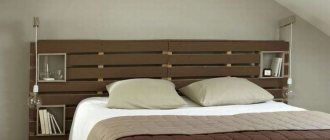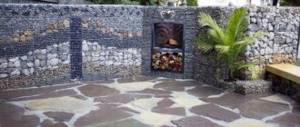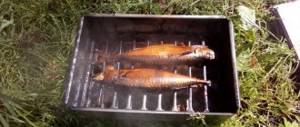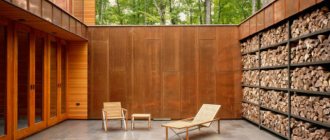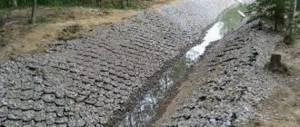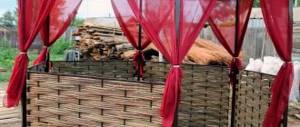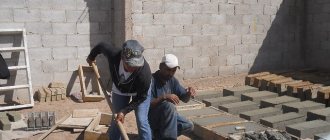You can start making money producing tandoor flatbreads with minimal investment. A tandoor, the main production element, can be purchased for 50-100 thousand rubles. or even make it yourself. The technology for making flatbreads is extremely simple and does not require much study or special skills. In some cases, in order to open your own tandoor mini-bakery, you will need a room with an area of only 15-25 square meters. m. At the same time, the flatbreads themselves can be sold directly at the place where they were baked...
About tandoor flatbreads
Tandoor flatbread is a national product of many Central Asian peoples (Uzbeks, Tajiks, Kazakhs, Kyrgyz, Uighurs). This delicious product has a very common composition of ingredients: wheat flour, milk, yeast, margarine, water, sesame and poppy seeds. It is prepared in a special oven - tandoor. Tandoor flatbreads are usually consumed with tea, hot dishes (pilaf, shish kebab, shurpa), as well as to make sandwiches with cheese, sausage, honey, etc. The average price of one flatbread weighing 250 grams is 30 rubles. at a cost of 5 rubles. When fresh, such a product is sold out with a bang, especially in large cities, where fresh baked goods are in great demand. Individual points located in high-traffic areas (stops, metro) sell more than 300 flatbreads per day. The monthly turnover of a small trading department can reach up to 300,000 rubles. of which approximately 50% is profit.
Making tandoor from clay
If you decide to build this unusual stove with your own hands, decide what material you will make it from: clay or brick.
In the old days, a classic tandoor was not built, but was sculpted by hand from clay. This method is still common today.
1. We start with the base equipment.
- Dig a small ditch, shaped like a donut, into which you will then place stones.
- Fill the space between the stones with a solution of cement and sand or sprinkle with an even layer of sand (10 - 15 cm). The sand will remove moisture from the clay from which the oven will be built.
- Lay fireclay bricks on top of the sand using a level. This will be the base of the tandoor.
- Prepare a clay solution.
To prepare the solution you will need well-frozen clay, sifted through a sieve. The clay must be soaked in water for 3 days, during which periodically knead it with your hands or feet. Upon completion, mix sheep or camel wool and 2 parts river sand into the clay.
The exact composition has been passed down from generation to generation by oriental masters for centuries, but you can try to make it yourself, varying the amount of ingredients. From the clay solution you need to make rollers (6-7 cm), strips with the same thickness or balls with the same diameter. They need to lie in the cold for 2 days.
We are building the walls of the tandoor.
Step 1. We will need thick, moisture-resistant cardboard to make a cone with the following dimensions:
- lower part with a diameter of 50 - 60 cm
- the upper part with a diameter of 35 - 40 cm.
We install the cone in the center of the base, and then cover it with prepared clay.
Step 2. Sand can be poured inside the cone, this will prevent it from deformation and compensate for the pressure of the clay from the outside.
Step 3. When the height of the walls reaches 70 - 75 cm, we form a sand hemisphere and cover it using wet newspapers. We put clay on top of this structure. This will be the upper form of our tandoor, which will allow us to use the heat of the stove rationally.
Step 4. When the clay “sets” (by about the second day), the top needs to be cut off. You can mark the cut using a bucket of suitable diameter. In the lower part we simultaneously form a blower 15 by 15 centimeters. Craftsmen can also make a door for it.
Step 5. After a week, the sand and the cone from the cardboard can be removed, and the tandoor will continue to dry for another 7 - 14 days. It is important that during the drying time of the clay there is no precipitation that could damage the structure.
Step 6. Only when it is completely dry will it be time for the first fire. After it, both the second and third fireboxes are made to make sure that there are no cracks in the stove. If they are still found, then they can be sealed with the same clay solution, but with the addition of sand in a ratio of 1: 4 or 1: 5.
We use the same solution to treat the inner surface of the tandoor.
The finishing touches.
- If you add straw or sawdust to our clay solution, the mixture will help to further insulate the tandoor, which will significantly increase its efficiency.
- Give your stove an attractive look and extend its service life by plastering it.
- Build a lid from clay or metal, insulate it with non-flammable material, which will allow you to use it as an oven.
Your clay tandoor is ready!
Options for starting a business
First, let's look at several ways to start a business baking tandoor (and Uzbek) flatbreads. Depending on the size of the starting capital, this may be:
- Separate mini-bakery. Premises are rented in the suburbs, equipment is installed, and personnel are hired. In this case, the products are sold to partner retail outlets. These could be bakeries, pastry shops, bread kiosks and grocery stores in the nearest city.
- Production of flatbreads at the point of sale. It is somewhat more difficult to find premises for such a business, but due to the aromatic smell of baked goods, there will be no end to buyers. This is one of the most expensive options, since it will be necessary not only to properly equip the bakery premises, but also to install commercial equipment and display cases.
- Franchising. The least risky option is to purchase a tandoor bakery franchise. The organizational process will be much simpler, since the franchisor will provide all the necessary equipment and technology. All you have to do is find the premises, and the money accordingly. Bakery franchising offers can be found in the franchise directory on our website.
A mini-bakery is too complicated or expensive for you, and you want to learn more about how to make money from investments and get a good income? You should attend the free marathon “Passive Income -2019” about current ways to invest money wisely.
Professional business plans on the topic:
- Bakery business plan (22 sheets) - DOWNLOAD ⬇
- Tandoor business plan (17 sheets) - DOWNLOAD ⬇
Types of tandoors
The basis of any tandoor is a clay vessel, shaped like an egg with a flat bottom, but there are many options for its execution.
Depending on the location and method of installation, the following types of oriental stoves are distinguished:
- earthen (embedded in the ground);
- above-ground (with or without foundation);
- portable;
- electric tandoors.
Earthen ones are considered the most ancient type of tandoor, which became the next stage in the evolution of a fire hidden from the wind, on which food was cooked. Owners install modern earthen tandoors permanently, their top rises 30-40 cm above the ground. This is a common phenomenon for the peoples of Asia, a familiar item of their everyday life. In the civilized world, not many people prefer them, since they are less convenient to use and require skills for independent construction.
Ground-based options are also stationary oriental ovens, which are used by public institutions: cafes and restaurants.
They have a number of undeniable advantages:
- size - they reach one meter in diameter, which means they can feed a large number of people;
- keep warm much longer;
- fuel consumption is 2-3 times less than that of a portable tandoor.
Portable ovens, in turn, have deservedly gained popularity - both among private users and in the world of business and catering establishments.
And there is a reason for this, since portable tandoors:
- mobile - easy to carry and transport from place to place;
- more convenient to use;
- have a beautiful aesthetic appearance;
- the manufacturer completes them with the necessary accessories: a poker, a scoop, a wheel, skewers and a device for installing skewers.
For those who want to install a tandoor in an apartment, manufacturers offer a civilized option - an electric tandoor with an open air heating element. And although it looks no less elegant than a portable one, it is significantly inferior in its characteristics: the heating element dries out the air, drying out the food as well. Therefore, an electric tandoor, on which you can cook truly delicious food, looks like an ordinary electric stove, and the cooking process in it is controlled by an on-board computer. Of course, its advantages are supported by the corresponding price.
What equipment to choose for baking tandoori flatbreads
The choice of tandoor for business purposes should be approached responsibly. Any savings at this stage will not hurt, but excessive stinginess can work against a businessman. What you definitely can’t skimp on is the type of material. Real tandoors are made from clay with the addition of sheep wool. But there are also cheaper analogues made of brick and cement on the market. It will not be possible to cook a real flatbread in such a “tandoor”. After some time, the cement tandoor begins to release crumbs that remain on the product. As a result, the cook has to constantly shake them off the tortillas, slowing down the entire production process. In addition, do not forget about the environmental component. Today, many harmful chemical elements are added to the cement solution, which then affects the product that is prepared in such a tandoor. However, it is up to the businessman to decide whether to make a quality product or work against his conscience. Also, a real tandoor must be fired in a special oven before use. This way it will last much longer. Many beginners don't know about this.
How to make a brick tandoor with your own hands, instructions and photos
A tandoor is a Turkish outdoor oven with a rounded shape, the main purpose of which is to cook dishes by baking them. You can bake bread, flatbreads, cook meat and other equally delicious dishes in it. In this article we will look at the stages of building a tandoor oven with our own hands from brick. Historically, the tandoor oven was made of clay and was a portable hearth that nomadic tribes took on campaigns. But over time, with the advent of settled tribes, the stove took on more powerful dimensions with stationary placement.
Today they come in two types, stationary and portable, the construction of which is mainly made of brickwork with clay mortar. The stationary type of tandoor is divided into two subtypes: pit and above-ground, the construction of which is carried out using underground and above-ground methods. Having your own home, you can build a tandoor in your yard, although this is not an easy task. In order to understand how to make a tandoor from brick with your own hands, you need to understand the principle and structure of the stove.
Types of tandoor stoves
According to the type of firebox, tandoors are electric, wood and gas. Electric ones are used much more often, but gas ones can be useful where there is no possibility of supplying electricity. Only wood-fired tandoors can give the real flavor to flatbreads, but their use for economic purposes is less justified. Another subtle point is the installation of a tandoor. The procedure, as it turns out, is not so simple, but very important, which you should trust to the master. After installation, the walls of the tandoor increase to 20 cm, which allows you to retain heat inside the structure longer. On a professional tandoor you can make up to 50 flatbreads every 15 minutes. That is, in just a couple of morning hours you can produce up to 500 cakes. This volume is enough to supply several retail outlets with products.
How to use tandoor
- The fire should be lit through a blower. To quickly heat up the stove and reduce the formation of smoke, choose dry wood.
- As soon as the first batch of firewood has flared up, a new one is added.
- After the flame has escaped from the neck, let the fire “breathe” and cover the stove with a lid.
- They wait until the tandoor gets warm and hot, and the black smoke falls off the walls.
- After 30 minutes, select coals from the ash pit.
Now everything is ready to prepare the dish. This way we get organic food. If you want to get food with smoke, then it is better to leave the coals in the oven.
To make a miracle stove, you will need source material, a great desire and a video on which the tandoor is built with detailed instructions and recommendations. And by purchasing a ready-made tandoor, you have the opportunity to please yourself and your friends with delicious dishes. Having a tandoor at home is every person’s dream. But it is doable.
Assortment - what else can you make money on?
Any businessman in the baking business will confirm that it is very difficult to make money by producing only one or two items (unless you are a “general” supplier to a federal grocery chain). In addition to tandoor and Uzbek flatbreads, it is definitely worth thinking about the production of related items, such as khachapuri, samsa, pizza, sausage rolls, sweet pastries (roses, bagels, cakes, etc.) and so on. What will it give. Firstly, this will increase the bakery's turnover. Secondly, it will be possible to open your own retail sales points, because almost the entire range will be produced in your bakery. Retail outlets can be opened both indoors (in residential areas) and in bread pavilions and kiosks (including in shopping trailers).
Features when using the oven
The rules for using a tandoor are simple, the main thing is caution and lack of haste.
- When lighting the stove for the first time, it is recommended to raise the temperature gradually. To do this, dry firewood is placed in the oven, accounting for two-thirds of the entire structure. They should be ignited through a blower.
- Cooking products are loaded after complete combustion of fuel. Having evenly distributed the coals along the bottom of the tandoor, you can start cooking. One ignition is enough to prepare two dishes.
- Checking the readiness of the stove is done by running a stick along the inner surface of the stove; if the soot on it disappears and the wall is clean, the stove is ready for use.
- In the case of preparing flat cakes, the walls of the oven must first be cleaned of soot and ash accumulated from previous kindlings. It is in such ovens that the famous Uzbek flatbreads are baked.
- The degree of readiness can be adjusted using a blower.
- After finishing cooking, in order to cool the tandoor as quickly as possible, under no circumstances should you pour water on the walls, as large cracks will appear. The tandoor must cool down on its own.
To summarize the above, we can answer the question of how to make a tandoor from brick at home. The construction process is divided into several stages, each of which has its own nuances. The main stage is the laying of walls, which requires a responsible approach and fulfillment of all necessary requirements. The final shape of the furnace should be in the shape of a dome. By fulfilling all the requirements and listening to the recommendations of experts, the tandoor oven will last for a long time.
In addition to the article, we recommend watching a video on making a brick tandoor with your own hands:
Decoration of a tandoor bakery
Newcomers have many questions related to the registration of such a case. It is worth saying that the set of documents for registering a tandoor bakery is no different from registering a classic mini-bakery. A license is not required to carry out this activity. Certification is voluntary, but the declaration of conformity is mandatory. In addition, after the opening of the bakery, it is necessary to send notifications about the start of activities to Rospotrebnadzor, Pozhnadzor and the local administration.
Furnace shape and mouth
The shape of the stove can be different. But it affects the amount of fuel required for cooking to a very small extent. But the taste of dishes cooked in ovens with different shapes is not affected at all. The shapes of tandoors can be varied. They are made in the form of a sphere, oval, in the form of jugs, barrels, a simple pipe in the form of a well or conical. The diameter of the mouth of tandoors from Central Asia is 0.35 -0.7 of the diameter inside the oven, as if in the “lower back”; the same ratio for tonirs is 0.5 -1.0.
Stoves are usually not divided by type of product. An experienced cook can make any food in any tandoor, and the process can be regulated by the amount of fuel. But it is assumed that in tandoors in the form of a dome with a wide mouth it is easiest to prepare dough products. It is convenient to strengthen the dough inside them and there is more space for it. Other tandoors can be used for cooking meat and fish without any problems.
Step-by-step opening plan
To open a mini-bakery for the production of national bread, you need to choose:
- The place for a mini-bakery should not be nearby competitors, large bakeries or other small bakeries. It is good to locate production in a residential area, in the private sector.
- The room for making flatbreads, which, according to SES standards: should not be semi-basement, must have running water, a bathroom and ventilation systems.
- An important aspect is technology and recipe;
- Sales plan for finished products.
Care should also be taken about advertising finished products. Start with social networks, since advertising there today is one of the most effective and completely replaces the more expensive contextual one. smmbox.com will help you fill the group with suitable content
The principle of operation of the tandoor
The process of cooking remains unchanged: firewood is placed at the bottom, which is set on fire and burns out. Here the principle is similar to the barbecue. But! This is where the similarities end. During burning, the walls of the jug heat up. During combustion, soot forms on the walls, which then crumbles, so you don’t have to worry about cleanliness. After the end of combustion, prepared semi-finished products are placed inside. These can be vegetables, tortillas, bread and much more. Fortunately, there are many recipes on the Internet. But the point of cooking is that the food is not fried (as on a grill), but simmered. The neck closes, so the heat doesn't escape anywhere. Cooking takes very little time.
You can buy a tandoor in Moscow very simply, as there are good and trusted manufacturers. Now there are stationary and portable models, large (perfect for restaurants) and small (which can be placed in a summer cottage).
Tandoors today are sold in a wide variety
How much money do you need to start a business?
The cost of a tandoor is relatively low - 50-100 thousand. You can make a tandoor oven yourself. Then you will only pay for the construction materials and the work of the stove maker. To accommodate a tandoor oven, 15-20 square meters are enough, the rental of which depends on regional prices. If you have your own private house, you can organize a mini-bakery on the premises.
Professional business plans on the topic:
- Bakery business plan (22 sheets) - DOWNLOAD ⬇
- Tandoor business plan (17 sheets) - DOWNLOAD ⬇
Construction of a tandoor oven with your own hands from brick
Like any construction process, the construction of a brick tandoor consists of several stages. It is recommended to produce it during the warm period of the year, since the masonry mortar retains its functions and structure only at above-zero temperatures. How to build a stove, main steps.
Project
The first step is to create a project for building a furnace. It includes:
- The choice of location is carried out according to the following criteria:
- the area should have the lowest humidity;
- the location of the stove should be away from the house and garden plantings;
- the place should not be on a hill;
Having chosen the appropriate option, the selected place must be removed and well leveled.
- Choosing the type of tandoor, which can be horizontal or vertical.
- Drawing up a drawing of the planned furnace and the foundation for it, indicating all the parameters.
- According to the drawings, a preliminary calculation of the required building materials is made.
- Drawings are necessary not only for preparing the material, but also for preliminary calculation of the cost of building a tandoor.
Preparation
fireclay brick
The next stage is the preparation of materials and tools needed during the construction process. To build a brick tandoor with your own hands you will need the following materials:
- fireclay refractory bricks, the quantity of which depends on the size of the furnace, on average up to 1 thousand pieces;
- for different mortar compositions, you need fireclay clay, sand, crushed stone and cement.
Required equipment:
- lattice or reinforcement necessary for pouring the foundation;
- a piece of asbestos pipe, which is necessary to make a blower;
- wooden blanks for assembling a template according to which the walls will be laid. Without a template, it is almost impossible to make a circle of the correct shape and the upper arch;
- a shovel, trowel, and level are necessary throughout the entire construction process.
Foundation
The third stage is the construction of the foundation for the tandoor. It is necessary for the stability of the furnace. The type of foundation depends on the soil on which the tandoor is planned to be built. If the soil is clayey, the foundation will need to be reinforced and it is best to use a columnar one. For sandy soil, it will be enough to cast a monolithic slab.
Foundation pouring technology:
- A hole is dug, the diameter of which should be slightly larger than the size of the future furnace.
- The depth of the hole must be dug taking into account the laying of the sand cushion and the thickness of the poured slab, on average it is 15–20 cm.
- Having leveled the bottom of the hole, a sand cushion 10 cm thick is poured in and compacted well.
- A reinforcement grid is laid on top of the sand and filled with concrete mortar; to strengthen the foundation, a layer of crushed stone can be poured before laying the reinforcement; it should also be compacted.
- In order for the foundation to rise above ground level, formwork is made, with its exposure to the surface by an average of 10–15 cm. This arrangement of the foundation prevents the masonry from being washed away by rainfall.
- After pouring the solution, the surface must be well leveled and checked with a building level.
Foundation solution:
- 3 parts sand
- 1/3rd part of gravel (fraction size no more than 1 cm);
- 1/3 cement.
After kneading these components, the consistency should be like thick sour cream.
Setting time for concrete is 72 hours. It takes at least 7–10 days for it to dry completely.
Important! During the drying process of concrete in the summer, the surface must be moistened to prevent the appearance of cracks and chips.
Base
Let's move on to the construction of the tandoor. The first thing that needs to be done is the base of the furnace, for the laying of which special bricks are used. It has great endurance to elevated temperatures and does not absorb moisture, and due to its dense structure it can withstand heavy loads. The advantages of fireclay bricks also include its resistance to temperature changes, making it ideal for the construction of outdoor kilns.
Before laying fireclay bricks on a concrete foundation, it is necessary to lay a waterproofing layer, which can be a sheet of roofing material.
The base is made in the shape of a circle. Therefore, you first need to use a special pattern to draw the boundaries of the circle.
The bricks are laid out in order, and at the end of the laying, unnecessary parts and corners are cut off using a cutting wheel, forming a round, even base.
Walls
The construction of brick walls is the most critical stage in the construction of a furnace.
Brick wall laying technology:
- Before starting work, it is necessary to assemble a wooden template, with the help of which the correct shape of the furnace circumference will be adjusted.
- The laying of bricks begins at the base of the furnace, which are installed on their end in a vertical position.
- The masonry is held together with a kiln mortar, the base of which is fireclay clay, quartz sand and a plasticizer. In order for all the elements of the structure to adhere tightly to each other, a large amount of solution is needed.
- Having laid the first row, a small gap is left for the future blower; to do this, we insert an asbestos pipe in which it will be necessary to install a valve to adjust the draft.
- For a stove whose height is 1.2 meters, it is enough to lay out 4 rows of bricks (with the condition of vertical laying).
- Each row, after laying them, is tied together with wire, the ends of which must be hidden in one of the seams.
- The last row of bricks is laid at a certain slope, inside the furnace, forming its neck. To do this, it is recommended to trim the brick using a grinder.
Finishing
Finishing work is the last stage of construction. This includes coating the inner surface of the oven with clay mortar, and finishing the outside with natural stone.
The clay coating layer on the inner surface must be at least 10 cm. The upper edge is made in the form of a roller.
After finishing the coating process, the structure must be allowed to dry thoroughly. To protect the structure from external environmental factors, such as rain or sun rays, it is recommended to cover the structure with cellophane during this period.
External finishing can be done in different ways; for better heat retention, a square brick frame is built outside the structure, and the gaps between the outer surface of the stove and the frame are filled with clay mortar. This method not only serves as a heat insulator, but also gives the stove an aesthetic appearance. A roof is not provided for the tandoor, since when the fuel burns, the fire rises high above the boundaries of the hole.
Since a tandoor cannot have a roof, a special iron lid of any shape is made to fit the size of its opening. It not only prevents debris and sediment from entering, but also promotes uniform heat distribution during cooking.
Do you need permits to open a mini-bakery?
Baking production, which means the production of tandoor flatbreads, is not licensed. But you will need product certificates and approvals from sanitary, fire and environmental inspections.
( 9 ratings, average: 4.00 out of 5)
Loading…
Similar business ideas:
- TOP 30 business ideas with minimal investment
- Chatbot marketing: is it possible to get a good income...
- 21 working business ideas on how to make money on...
- How to start a pottery business with minimal expenses...
Text of the book “We make our own smokehouses, grills, barbecues, outdoor ovens”
Tandoor for baking flatbreads
This tandoor model is designed for baking bakery products - flat cakes and pita bread.
The basis of the stove is a jug-shaped ceramic firebox. It is made in a pottery workshop from refractory clay with an admixture of fireclay sand. It is fired in large furnaces at a temperature of 1050 °C and then placed in the kiln. A metal smoke collector made of sheet steel 1.5–2 mm thick is installed above the stove. The smoke collector is made removable and, after heating the tandoor, it is removed so as not to interfere with the baker’s work. A steel or brick stationary chimney is installed next to the tandoor. The tandoor smoke collector is connected to it at an angle of no more than 45°. The structure of such a tandoor is shown in Fig. 122. Fig.
122. Tandoor oven for baking flatbreads:
a
– sketch;
b
– furnace structure (
1
– ceramic fuel vessel, wall thickness 20–25 mm;
2
– heat accumulator – fireclay masonry;
3
– thermal insulation (mixture of vermiculite and clay in a ratio of 2:1);
4
– external brickwork;
5
– grate;
6
– ash door;
7
– ash chamber;
8
– ceramic rim);
c
– general structure of the tandoor (
1
– steel mast-pipe;
2
– inclined chimney;
3
– fastening of the inclined chimney;
4
– place of attachment of the smoke collector;
5
– smoke collector;
6
– smoke collector door for loading fuel;
7
– tandoor)
The stove is heated for 1.5–2.5 hours, then cleaned of ash and coal residues. After cleaning the firebox, you can cook baked goods in it. Fuel for combustion is loaded through the upper neck of the tandoor and the door in the smoke box. Firewood burns on a grate. Combustion air is supplied through the ash door.
Improved tandoor oven for roasting meat
This hearth is an improved design of the tandoor, in which you can cook meat and fish dishes, fry kebabs, large pieces of meat, carcasses of animals and game, poultry, as well as prepare cold and hot smoked products. Unlike real Asian tandoors, it is made of bricks laid on clay mortar (Fig. 123, a
). Thanks to this, it is always possible to grease cracked seams formed due to incorrectly selected clay. In a real tandoor this is impossible - all the work would have to be completely redone.
The tandoor firebox has the shape of a truncated cone (Fig. 123, b
). A blower door and a grate are installed at the base. An exhaust chamber equipped with a metal door is laid above the brick firebox. This camera performs several functions. Through the door and neck of the firebox, fuel is placed into the tandoor, which burns on the grate. Flue gases collect in the chamber and go into the chimney (the classic Asian tandoor does not have a chimney or smoke collector). Products for frying or hot smoking are suspended through the chamber into the tandoor. Products for cold smoking are also suspended in the chamber itself. To do this, place a metal container with sawdust on the neck of the firebox, which, when heated, begins to smolder and emit smoke. The container should be placed on a stand so that between it and the neck of the tandoor there are holes for the flue gases to escape from the firebox. Also, with a stand, you can place a frying pan, saucepan or cauldron on the neck of the tandoor for cooking pilaf and other oriental dishes.
You can cook flatbreads on the hot walls of the tandoor.
First and second rows
tandoors are laid out with continuous rubble masonry (you can fill the base with a height of 140 mm with concrete). The furnace is laid according to the order (Fig. 124). Before laying out the firebox, thermal insulation is laid in its cavity, which is prepared by mixing 2 parts vermiculite with 1 part clay.
To the 31st row
a frame made of steel angle 63 × 63 mm is installed.
To the 32nd row
install a metal smoke collector-umbrella made of steel sheets 2–3 mm thick. A chimney with a cross section of 250 × 250 mm is also made of steel sheet. Instead, you can install a round steel pipe ∅ 250 mm.
Rice.
123. Tandoor construction:
a
- general form;
b
– device (section);
c
– smoke collector hood;
1
– chimney (steel);
2
– smoke collector body (steel);
3
– funnel – gas threshold (steel);
4
– funnel supports;
5
– direction of movement of flue gases;
6
– brickwork;
7
– top of the tandoor;
8
– firebox;
9
– thermal insulation;
10
– grate;
11
– under the firebox;
12
– blower door;
13
– ash chamber;
14
– double-leaf firebox door (steel)
Rice.
124. Tandoor procedures
Simple tandoor from a barrel
If you have difficulties purchasing a ready-made ceramic tandoor, and the construction of the above-described structures for one reason or another does not inspire you, you can try to master the wonders of tandoor cooking by making a very simple vertical tandoor oven. To do this, you will need a brick (better, of course, fireclay), clay, a cast-iron grate larger than a brick or a set of grates and a standard 200-liter metal barrel. Provided that you have the clay solution prepared, all the work on constructing the furnace will not even take a whole day!
First of all, remove the top lid of the barrel and make sure that it is clean inside, that is, no lubricants or paint were stored in it (you are unlikely to like kebab with the smell and taste of fuel oil). Then, stepping back from the bottom to the thickness of two bricks, use an angle grinder to cut out a window corresponding to the size of the end of a standard brick (Fig. 125, a
). This will be the outlet of the blower.
Now we begin to fill the barrel with bricks. First row
lay them so that whole bricks are located in the center, with a spoon parallel to the plane of the blower window (Fig. 125,
b
). Along the edges, where a whole brick does not fit, halves and quarters are used, and the remaining space is filled with large brick scraps and filled with clay mortar.
Second row
is filled in the same way, but the arrangement of whole bricks in the center is perpendicular to the previous one, and a pair of whole bricks should be coaxial with the blower hole (Fig. 125,
c
).
In the third row
bricks can be laid in any order, but at the same time the same one from the blower window to 2/3 of the barrel diameter should remain unfilled (Fig. 125,
d
).
This is how the air channel of the blower is formed. We place a metal grate or a set of grates on top of this channel (Fig. 125, d
). It is advisable to wrap the corners of the grate or the edges of the grate with thick wire and lower its ends into the cracks between the bricks of the third row in order to fix the grate and prevent it from moving while cleaning the tandoor. In any case, fill the surface around the grate with broken bricks and fill it with clay, bringing it into the same plane as the grate.
Rice.
125. Simple tandoor from a metal barrel:
a
– a prepared barrel with a hole cut out for the blower;
b, c, d
– rows of hearth;
d
– under with a grate (before filling with clay);
e, g
– rows of firebox;
h, i
– neck rows;
k
– tandoor in section (letters indicate the corresponding rows);
l
– top cover (bottom view);
m
– bottom cover (front view);
1
– barrel;
2
– brick;
3
– clay solution;
4
– vent opening;
5
– grate
At this point we can assume that it is ready for the oven. Now it's up to the firebox. It is formed by two rows of bricks installed around a circle in a vertical position. the fifth row dry and as tightly as possible
brick (this is actually the first row of the firebox), fill the cracks with clay mortar and compact it (Fig. 125,
f
).
To prevent bricks from crawling into the firebox, install spacers before working with clay or place a rubber bladder inside, for example from a soccer ball. When you inflate the bladder, it will press the bricks tightly against the inside of the barrel. Having finished with this row, we lay the sixth row
(the second row of the firebox) in exactly the same way, moving along the circumference by half a brick, that is, by tying the seams (Fig. 125,
g
).
The masonry is completed by two rows of four bricks laid flat in a diamond shape (Fig. 125, h
), also shifted around the circumference, but by 90° (Fig. 125,
and
). We fill all external voids with clay, and the masonry is complete!
While the tandoor is drying (and it should dry well, which will require several days in the sun), you can slowly build the lids. The top cover, which covers the neck of the firebox, can be made in the form of a wooden round shield with a handle, upholstered underneath with roofing iron. In the center you can arrange an additional seal - in the form of a diamond, corresponding in size to the neck opening (Fig. 125, l
). True, even a well-fitted lid is usually not enough, and in order to better retain heat, felt or a warm blanket is placed on top of it.
With the bottom cover the situation is even simpler - its function is performed by an ordinary brick (Fig. 125, m
), which is pushed into the blower window when the firewood and coals have burned out and the cinders and debris that spilled through the grates have been removed. For convenience, you can attach the brick with its end to a metal plate with a handle or a metal-covered wooden block using a pair of anchor screws (you should not use standard dowels for this, since the plastic will instantly melt from the heat, and the wooden plugs will char).
Simple brick tandoor
In a similar way, you can fold a tandoor without a barrel (Fig. 126, a
).
To do this, you will need the following materials: fireclay bricks (300–1500 pieces depending on size), ready-made dry kiln masonry mixture (one of the commercial names is “Heat-resistant clay-fireclay masonry mixture”), which is diluted with water to the desired consistency, cement, ordinary construction sand, knitting wire, metal mesh (chain-link) and grate. For the foundation, we dig a pit with a depth of a spade bayonet measuring two times the diameter of the base of the tandoor. We fill it halfway with sand and fill it with creamy oven mortar up to ground level. We stick an even pole, a metal rod or a water pipe exactly into the middle and set it vertically along a plumb line - a rotating template will be attached to this stand, that is, a wooden frame, along the outer edge of which a brick circle is laid out (Fig. 126, b
). The shape of the template must be linked to the size of the brick and the permissible thickness of the joints (3–13 mm).
Rice.
126. Simple brick tandoor:
a
– tandoor in section;
b
– laying a round firebox according to a template;
1
– concrete foundation;
2
– blower channel;
3
– rows of the base;
4
– grate;
5
– rows of firebox;
6
– wire tying;
7
– coating with clay-straw solution;
8
– metal mesh;
9
– coating with cement-sand mortar;
10
– welding;
11
– neck ring;
12
– template stand;
13
– clamps;
14
– template frame
We lay the base on the foundation in the same way as in the previous design - with three or two layers of brick, but we form the ashpit from the first row
. On the base we build a firebox of red bricks, placed on a stick and folded into a ring using a template. 19 bricks make a circle with a diameter of 40 cm. Lay out the first row of bricks dry. Having laid out, adjusted the width of the seams and leveled them with a full turn of the template, we take out the bricks one by one, dip them in clean water for a second, apply a dough-like masonry mortar to the poker and beds and insert them into place. At the end of the row, we turn the template again and level it. We work slowly so as not to redo it.
Since the construction of such a tandoor is a lengthy process, work should be carried out under a canopy. After all, an unexpected rain will wash away the long-drying clay solution and everything will have to start again.
To prevent the structure from falling apart, we wrap it tightly, in several turns, with wire. Then we build one or two more of the same “floors.” In this case, you need to try to maintain the dressing of the seams between the rows: install the first brick of each subsequent row in the middle on the seam between the bricks of the previous one. If the shape of the tandoor is cylindrical, then this is where the masonry features end. If you decide to make a conical oven, this can be done in two ways - with a row shift or with an inclination. In the first case, at the stage of calculating the template, another rule must be observed: the protrusion of the row inward is no more than 1/4 of the width of the brick. In this case, the inside of the oven will have to be lined with mortar to smooth out the protruding edges. The second option, which does not require internal lining (but is less durable), is to lay the bricks with the bricks tilted in a vertical plane. With any of these options, complete dressing will not work, since the diameter of the rows changes smoothly. Therefore, we begin the laying of each subsequent row not from the same place as the previous one, but shifting by 1/5 - 1/3 around the circumference; It’s convenient to navigate around the ash pit. This technique is called dressing through rows.
When the firebox is built, we remove the pole with the template and coat the outside of the tandoor wall with the masonry mixture again, sealing the seams. We pre-moisten the dry edges of the brick with water so that the mortar adheres better.
Cover the outside of the dried base of the firebox completely with clay. For a clay solution, three ingredients are needed - clay, water and straw, which are thoroughly mixed.
Then we reinforce the tandoor with a metal reinforcing mesh, which we tightly wrap around the firebox. The mesh can be wrapped not once, but twice or even three times - the walls will be stronger.
The neck of the tandoor can be the same as in the previous project, but in this case it is better to make it in the form of a metal ring, to which we weld the upper edges of all layers of the mesh. Finally, we coat the outside of the entire structure with mortar, and in order to prevent the clay from getting wet under the influence of precipitation, a cement mortar can be used for external coating.
Firing and commissioning
After the tandoor has dried, it must be fired well. First - paper, cardboard or wood chips. We set fire to a handful and throw a handful at a time through the mouth until the outer wall becomes slightly warm. Then cover with a lid and let cool completely; This will take about a day. After this, the tandoor with a metal surface (barrel) can be completely fired. For a completely ceramic tandoor, the amount of material for the firebox will have to be gradually increased over two weeks, until the water that gets on the outer surface begins to boil, shooting off and splashing. You can’t pour too much; even a glass can ruin a tandoor that isn’t fully annealed.
For final firing, fill the tandoor 1/4 full with standard fuel and let it burn to charcoal. Add fuel in the same portions until the tandoor is at least half filled with smoldering coals. It is better to take firewood that burns out quickly, but smolders slowly (cherry, apple) so that the level of the coals approaches the mouth. As the fire proceeds, the walls are cleared of soot (it gradually burns out) and take on a natural appearance.
Let it cool, still under cover. In this case, you need to be careful and follow fire safety rules: the hot stream of air from the tandoor will be very powerful. After the tandoor has cooled down, unload the ash, and the tandoor is ready for use.
To cook food, the stove must be well heated (firing does not count) - load dry firewood into the firebox no more than 2/3 of the volume (initially 1/3, and after 15–20 minutes add another 1/3 of the volume) and light it . The operating temperature is reached after approximately 1.5 hours of dynamic heating of the tandoor, depending on the firewood used, its quantity, and the volume of the firebox. At this time, using the adapter ring, you can install a cauldron on the neck of the tandoor and cook pilaf or porridge, boil water. In this case, covers are not installed on the tandoor. In portable Uzbek tandoors the lid is made double; At the end of the fire, the smaller one is removed. Its nest in a properly made tandoor has a jagged shape, and you can place a kettle on it without disturbing the draft.
After the end of the main phase of burning wood, to preserve heat in the tandoor, you can install a large lid on the neck, and after the flame has completely disappeared, close the vent.
Cooking in the tandoor itself begins when the fuel burns down to the coals. A prerequisite is that the soot and soot on the walls must also burn out. With good quality fuel, this is always observed. Now you can start loading skewers, hooks, grates or other accessories with pre-prepared semi-finished products. In a tandoor from a barrel, the bottom row of the square neck of the firebox forms four protrusions, one or two metal rods are placed on one of them, on which skewers with skewered meat are hung or a pot of vegetables or other food is attached (Fig. 127, a
). Instead of rods, you can weld a hanger to the size of the neck - a rectangular frame with crossbars that will perform the same function (Fig. 127, b). This option is more convenient and reliable - in one motion, the frame with all the skewers can be loaded into or removed from the tandoor. In order not to burn your hands, it is better to attach such a frame with a metal hook on a long handle.
For tandoors with a cylindrical neck, similar devices are used, only round in shape, corresponding to the hole in the neck of the tandoor. For example, a hanger for skewers, hooks and racks (Fig. 127, c
).
The grates for baking vegetables are made in a similar way, only they are smaller in size to fit into the neck, and they are held in place by brackets, with which they rest on the neck. There can be several such grids in the so-called whatnot (Fig. 127, d
).
A very useful thing, which has already been mentioned, is a steel adapter ring that allows you to install a cauldron on the neck of a tandoor (Fig. 127, d
).
And in order to bake large pieces of meat or even whole carcasses, hooks are used (Fig. 127, f
). In this case, it is advisable that a bowl be hung below the hook with the product, for example on chains, into which the fat will drain. You can also stew vegetables in it at the same time.
Separately, a few words need to be said about the skewers used in the tandoor. They differ from the usual ones, on which barbecue is fried in a grill. When positioned vertically, the meat will inevitably slide off straight, straight skewers and fall onto the coals. Therefore, skewers for tandoor in the lower part (or even along the entire length) have a wave-like or helical shape, which allows the products to be held well (Fig. 127, g
).
The first pieces of meat are skewered as usual, and the last pieces are skewered and turned 90°. They will also retain the top products. And if making such skewers causes any difficulties, you can go another way: make skewers with a curved end from a round rod (Fig. 127, h
).
Rice.
127. Accessories for tandoor:
a
– general view of a tandoor with a square neck with skewers suspended on rods;
b
– hanger for a tandoor with a square neck (the size corresponds to the opening in the top row of the neck);
c
– hanger for tandoor with a round neck;
d
– two-tier shelf;
d
– adapter ring for installing a cauldron;
e
– hook for hanging meat;
g
– flat skewers;
skewer with hook; 1
– supporting surface formed by the bricks of the lower row of the neck;
2
– supporting metal rods;
3
– skewers
The handle of tandoor skewers also has differences. Firstly, it is not ring-shaped, but is made in the form of a hook with which the skewer clings to the suspension. Secondly, there are two such hooks. The second is located above the first, and is, in fact, the handle by which the skewer is held when putting it on the hanger or pulling it out of the tandoor.
In addition to the above accessories designed for placing food in a tandoor, you will need a poker to clean the ash pit and a long-handled scoop to remove burnt coals from the firebox.
Stove with firebox for installing Asian cauldrons
An oriental cauldron is traditionally placed over a fireplace, and the fire evenly goes around all its sides, the smoke escapes into the atmosphere without a chimney, which interferes with the cook’s work - the smoke hurts the eyes, and combustion products and soot can get into the cauldron. In addition, the area where the cauldron is installed becomes heavily smoked.
The proposed design (Fig. 128) has a chimney and a chimney raised high above the stove, which does not interfere with the cook’s work and improves the quality of cooking. The design of the oven ensures uniform heating of the cauldron over its entire surface, which contributes to high-quality cooking while maintaining the oriental technology of cooking in cauldrons. In addition, this oven can also be used as a tandoor for frying whole carcasses of game, poultry, fish and small animals - rabbits, rams, piglets.
Rice.
128. Furnace design for installing an Asian cauldron:
1
– cauldron;
2
– steel plate 15–20 mm thick;
3
– frame made of steel corners;
4
– grate;
5
– combustion door;
6
– blower door;
7
– ash pan;
8
– firebox;
9
– lowering (collecting) smoke channels;
10
– burnouts;
11
– chimney;
12
– internal walls of the firebox;
13
– outer walls of the firebox;
14
– place of installation of the chimney
To prepare food, a cauldron is placed on the stove, the stove is melted and then heated with wood. To use the oven as a tandoor, it must first be heated well for 1–2 hours. Then, the firebox is cleaned of ash and unburned coals, food is hung up and the firebox is closed on top with a wooden round lid, under which food is cooked.
The furnace is connected to a free-standing (root) brick or metal pipe (not shown in the drawing). To do this, a channel is made on one of the sides or on the back side for the exit of flue gases and for connecting the stove to the pipe. The length of the connecting horizontal chimney must be no more than 2 m. Metal connecting and vertical chimneys must be thermally insulated. The cross-sectional area of the chimneys is at least 300 cm2.
The firebox in which the wood burns in this stove has a cylindrical shape. Flue gases exit in the upper part of the firebox into specially made holes - undercuts, go into the lower channel and from the lower channel exit into the chimney made in the lower part of the stove on one of the side or rear walls and go through the connecting chimney into the chimney.
The furnace is laid according to the procedures (Fig. 129). On the first and second rows
lay out the ash pan and install the blower door.
Rice.
129. Oven order for installing a cauldron
On the third row
lay fireclay bricks under the stoves and install a grate.
On the fourth row
install the combustion door, lay out the first row of a cylindrical firebox from halves of fireclay bricks and line the outer perimeter with fireclay bricks at a distance of a quarter of a brick from the outer walls of the furnace, thereby forming a prefabricated lowering channel.
On the fourth - fifth rows
On one of the side outer walls of the furnace, a hole (burnout) with a cross-section of 250 × 140 mm is made for the exit of smoke.
Rows four to eleven
lay out the lowering channels, a cylindrical firebox with a quarter-brick bandage and the outer walls of the furnace.
On the twelfth row
lay out holes (burnouts) for the exit of flue gases from the firebox into the down channels.
On the thirteenth row
cover the lowering channels with fireclay.
To the outer perimeter of the thirteenth row
install a frame made of steel angle 63 × 63 mm. A steel plate 15–20 mm thick with a hole for a round cauldron is installed on top. A layer of kaolin wool up to 5–10 mm thick is laid between the slab and the brickwork. The plate is not standard and is not produced by industry, but is manufactured according to individual orders and projects. Rings of different diameters are installed on the stove to install cauldrons. In the absence of a cauldron, the stove is completely covered with rings for installing other types of cookware.
